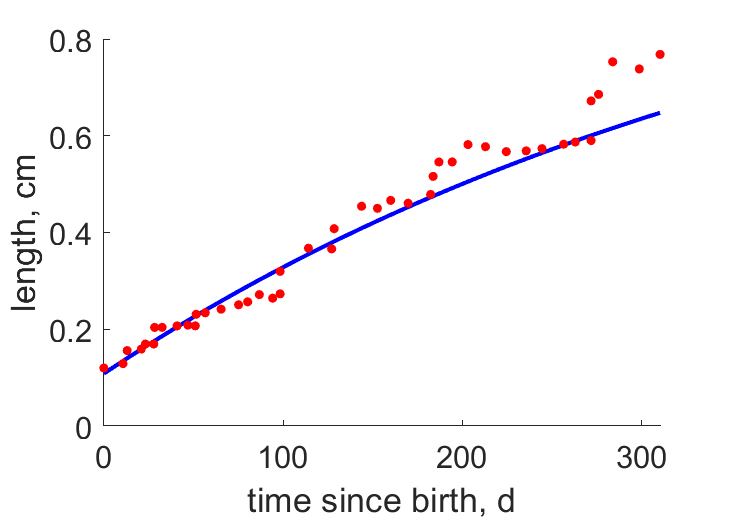Predictions & Data for this entry
| Model: abj | climate: MC | migrate: | phylum: |
| COMPLETE = 2.5 | ecozone: MAN | food: biCia | class: |
| MRE = 0.117 | habitat: 0jMp, jiMb | gender: D | order: |
| SMSE = 0.024 | embryo: Mbm | reprod: O | family: |
Zero-variate data
| Data | Observed | Predicted | (RE) | Unit | Description | Reference |
|---|---|---|---|---|---|---|
| ab | 32 | 29.32 | (0.08374) | d | age at birth | TomaWilh1997 |
| tj | 83 | 71.68 | (0.1364) | d | time since birth at metam | TomaWilh1997 |
| tp | 290 | 356.6 | (0.2295) | d | time since birth at puberty | TomaWilh1997 |
| am | 3285 | 3295 | (0.003093) | d | life span | TomaWilh1997 |
| Lb | 0.015 | 0.01428 | (0.04776) | cm | total length at birth | TomaWilh1997 |
| Lj | 0.071 | 0.09502 | (0.3383) | cm | total length at metam | TomaWilh1997 |
| Lp | 0.82 | 0.6106 | (0.2554) | cm | total length at puberty | TomaWilh1997 |
| Li | 1.01 | 1.123 | (0.1121) | cm | ultimate total length | TomaWilh1997 |
| Wwi | 0.077 | 0.07721 | (0.00276) | g | ultimate wet weight | guess |
| Ri | 150.7 | 150.7 | (0.0004044) | #/d | maximum reprod rate | guess |
Uni- and bivariate data
| Data | Figure | Independent variable | Dependent variable | (RE) | Reference |
|---|---|---|---|---|---|
| tL |  | time since birth | length | (0.07881) | TomaWilh1997 |
Pseudo-data at Tref = 20°C
| Data | Generalised animal | Pycnogonum litorale | Unit | Description |
|---|---|---|---|---|
| v | 0.02 | 0.0005472 | cm/d | energy conductance |
| kap | 0.8 | 0.9517 | - | allocation fraction to soma |
| kap_R | 0.95 | 0.95 | - | reproduction efficiency |
| p_M | 18 | 244 | J/d.cm^3 | vol-spec som maint |
| k_J | 0.002 | 0.002 | 1/d | maturity maint rate coefficient |
| kap_G | 0.8 | 0.8006 | - | growth efficiency |
Facts
- grasp hydranths of Clava multicornis (Hydractiniidae) as larvae and feed on their stolons (Ref: TomaWilh1997)
- loose larval extremities at 5th moult and change feeding from small hydroids to sea anemones (Ref: TomaWilh1997)
- number of juvenile moults varies between 6 and 8 (Ref: TomaWilh1997)
- juvenile also increase in length during intermoult; First increase can be due to uptake of water (Ref: TomaWilh1997)
- males carry the eggs on their ovigers till protonymphon larvae hatch (Ref: TomaWilh1997)
- prefers Metridium senile as food above Actinia equina and Tealia felina in British waters (Ref: TomaWilh1997)
- repeated mating as adults without further moults (Ref: TomaWilh1997)
- can starve for 18 months (Ref: TomaWilh1997)
- females deposit all their eggs in a single clutch on the male (Ref: JarvKing1972)
Bibliography